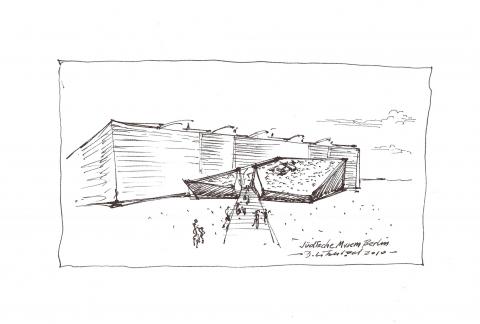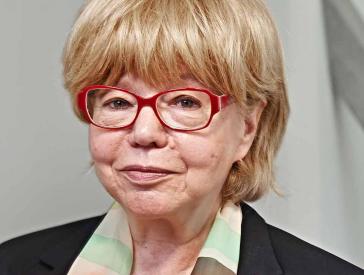
Our Museum’s History, Part Four
Since the Museum Opened in 2001 until the Present Day
The Jewish Museum Berlin has since established itself as a distinctive institution in the landscape of German museums. With its exhibitions, publications, educational work, and diverse events calendar, it is a lively forum for discussion about and contemplation of Jewish history and culture and, more broadly, migration and social diversity in Germany. It is a museum for everyone: young and old, Jewish and non-Jewish, and those from Germany and other countries.
- Financing the Museum’s Work
- A Focus on Visitors
- Our Core Exhibition
- Rafael Roth Learning Center
- Temporary Exhibitions
- Educational Work and Cultural Events
- Our Academy
- The Museum’s Management
Financing the Museum’s Work
As a foundation under public law, our museum receives annual funding from the Federal Republic of Germany; the remaining funds are raised through donations and ticket sales. Since 2002, the Prize for Understanding and Tolerance has been presented at the annual anniversary dinner with friends and patrons of the museum. The fundraising proceeds benefit the museum’s educational work for children and young people.
A Focus on Visitors
Around 700,000 people per year – or roughly 2,000 a day – have visited the Jewish Museum Berlin since its opening in 2001. On 19 November 2015, we welcomed our ten-millionth visitor.
The museum aligns itself to its visitors’ interests, which are researched in a department dedicated to this purpose. Friendly and competent members of staff are present in all public areas of the museum.
Our Core Exhibition
From 2001 to 2017, the first permanent historical exhibition lead you on a journey of discovery through two millennia of German-Jewish history across 3,000 square meters (32,000 square feet) of exhibition space. In fourteen periods from the Middle Ages to the present, the exhibition painted a picture of Jewish life. Objects from material culture, artworks, photographs, letters, interactive elements, and media stations portrayed Jewish culture in Germany and demonstrated how tightly intertwined Jewish life is with the history of Germany. The new core exhibition opened in 2020: completely redesigned and adapted to the latest state of research (more on the first permanent exhibition and more on the new core exhibition).
 X
X
Founding Director W. Michael Blumenthal, Federal Government Commissioner for Culture and the Media Monika Grütters and Museum Director Peter Schäfer (left to right) greet the ten-millionth visitor, Paula Konga (with bouquet), 19 Nov 2015; Jewish Museum Berlin; photo: Svea Pietschmann
In the broadcast rbb Kultur – Das Magazin from 23 May 2020, Franziska Hessberger talks to JMB director Hetty Berg about her concept for the museum, to organizational director Bülent Durmuş about the various buildings, to senior curator Cilly Kugelmann about the new core exhibition and to artist Yael Reuveny about her video work Mesubin (in German).
Rafael Roth Learning Center
Up until 2 April 2017, our Rafael Roth Learning Center offered diverse media applications that complemented the museum’s exhibitions. At computer workstations both large and small, individuals and groups could view a wide range of multimedia content connected to the museum’s main themes. Documents, objects, films, sound recordings, and interactive games illustrated the rich and constantly shifting history of Jews in Germany (more on the learning center).

This is what the Learning Center supported by Rafael Roth looked like; Jewish Museum Berlin, photo: Thomas Bruns.
Temporary Exhibitions
Our permanent exhibition on cultural history is complemented by temporary exhibitions. These last six months to a year and span a wide range of topics from history and society to contemporary art, photography, literature, and comics. There are also smaller exhibitions, with objects from our collection, across three exhibition spaces.
Educational Work and Cultural Events
The museum has a special focus on educational work. The extensive instructional programs, the research possibilities in our Library and Archives, and the varied events calendar are aimed at children, young people, and adults. Besides our regular guided tours and workshops, we also host talks, concerts, and readings. Each year, we organize a cultural summer program. From 2007 to 2018, our educational initiative “on.tour – The JMB Tours Schools” visited schools in all of Germany’s states with a tour bus and a mobile exhibition (more on our first on.tour program). From 2019 to 2021, we were on the road with a variety of workshops themed around the new Jewish Places website (more on those outreach programs), and from 2022 we are touring with new formats to accompany the new core exhibition (more on our current on.tour program). In addition, the Education Department designs materials for school lessons.
In November 2012, a database of selected museum holdings (in German) went online: http://objekte.jmberlin.de.
Our Academy
That same month, in November 2012, a new building by Daniel Libeskind was opened: the Academy of the Jewish Museum Berlin. Following Libeskind’s “In-Between Spaces” design, the Academy is integrated into the former wholesale flower market across the street from the museum; the building’s alterations were financed by a generous donation from Eric F. Ross.

The Academy of the Jewish Museum Berlin (aerial view, July 2013); Jewish Museum Berlin; photo: Jens Ziehe
Across 6,000 square meters (65,000 square feet) of floor space, the building houses our Archive, our Library, the Education Department, and the events for our Academy programs, which consist of the Jewish-Islamic Forum and a thematic focus on migration and diversity. Since 2013, our Academy programs have been devoted not only to the history and culture of German Jewry, but also the mutual relationships among religious and ethnic minorities. We have placed a renewed emphasis on the political, social, and cultural conditions necessary to guarantee the participation of minorities in society.
The Jewish Museum Berlin’s own fellowship program is increasing our museum’s visibility as a research institution. In late 2014, Dr. Karen Körber completed the first fellowship project, titled Everyday Realities: Contemporary Jewish Life in Germany, focussing on second-generation Russian-speaking Jewish immigrants in Germany. On the occasion of W. Michael Blumenthal’s ninetieth birthday, a fellowship in his name was launched as part of the Jewish-Islamic Forum. Our first W. Michael Blumenthal Fellow, who held the position from November 2016 to October 2018, was Walid Abd El Gawad with his post-doc project "To Know One Religion Is to Know None:" Reflections on Islam and Judaism in the Writings of German-Speaking Jewish Orientalists (1833–1955), which is shedding light on new aspects of the history of Jewish–Muslim relations in the modern age. From January 2017 to May 2018, our second W. Michael Blumenthal Fellow was the education scholar Dr. Rosa Fava. Her post-doc project, titled Didactics of the Middle East Conflict, investigated teaching and learning concepts and materials about the Middle Eastern conflict in education outside the school system. Her emphasis was on continuing training courses for teachers and other multipliers.
The Museum’s Management
Since 1 April 2020, the curator and museum manager Hetty Berg has directed the museum. Originally from the Netherlands, she has held various positions at the Jewish Historical Museum in Amsterdam.
From 1997 to September 2014, W. Michael Blumenthal was director of the Jewish Museum Berlin, followed by Jewish studies scholar Peter Schäfer who held the post until summer 2019. As program director and deputy director, Cilly Kugelmann (from 2002 to 2017) and Leontine Meijer-van Mensch (from 2017 to 2019) were shaping the programming of the house during these years.
In 2015, the Jewish Museum Berlin presented its Founding Director with the Prize for Understanding and Tolerance. In January 2016, it renamed the Academy the W. Michael Blumenthal Academy in his honor.

Here is a recording of W. Michael Blumenthal’s acceptance speech (in German) for his 2015 Prize for Understanding and Tolerance. He talks about his history with the Jewish Museum Berlin, but also about current politics and the museum’s new projects. His enjoyment of the honor was overshadowed by a terrorist attack in Paris that occurred the day before the acceptance speech.
Citation recommendation:
Jewish Museum Berlin (2020), Our Museum’s History, Part Four . Since the Museum Opened in 2001 until the Present Day.
URL: www.jmberlin.de/en/node/2013
History of the Museum: Ideas, Debates, Decisions, Inauguration (4)




 X
X

 X
X

 X
X














